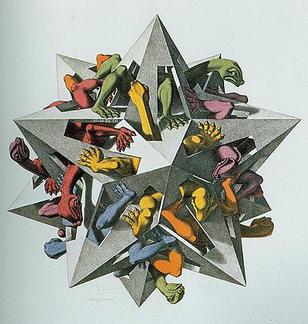| Gravitation | |
|---|---|
 | |
| Artist | M. C. Escher |
| Year | 1952 |
| Type | lithograph and watercolour |
| Dimensions | 29.7 cm× 29.7 cm(11.7 in× 11.7 in) |
Gravitation (also known as Gravity) is a mixed media work by the Dutch artist M. C. Escher completed in June 1952. It was first printed as a black-and-white lithograph and then coloured by hand in watercolour.
Contents
It depicts a nonconvex regular polyhedron known as the small stellated dodecahedron. [1] Each facet of the figure has a trapezial doorway. Out of these doorways protrude the heads and legs of twelve turtles without shells, who are using the object as a common shell. The turtles are in six coloured pairs (red, orange, yellow, magenta, green and indigo) with each turtle directly opposite its counterpart.